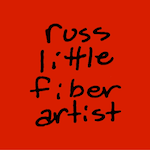Lessons from my 365: Transparency is a powerful tool. I just wish it was easier with dye.
The transparent affects that you see in the images below are just wonderful to my eye. In most cases, the transparency that you're seeing is similar to the effect you'd get from painting with an acrylic paint mixed with transparent medium.
Disclaimer: These images were created on a computer, and there's a bit more going on here than simple transparency. But I'm still using them to illustrate the difference between layering paint versus layering dye.
Painting a light color over a dark color produces a combination of the two colors because the base color shows through the transparent second layer. Applying multiple layers of transparent paint (seen clearly in the 3rd image below) increases the opacity of the transparent color. For example, applying multiple layers of transparent white paint over a dark background makes the white areas whiter with each successive layer.
Unfortunately (or fortunately, depending on your perspective), layering dye doesn't work the way layering paint does. All dye is transparent, and thus each layer is added to the previous layer. In this way, dye on cloth is most akin to watercolor paint on paper. You can never overlay one dye on top of another and get a lighter result. Building complex layering of color on dyed cloth requires thoughtfully planning the concentration of the dye solution and the order of layering, understanding the way that dye binds to fiber, and knowing how dye can be manipulated through resist and discharge techniques.
Some of the wonderful effects in these designs would not be achievable using the same layering I used to draw them on my iPad. Some would be just about impossible to achieve. Enter now the brave new world of digitally printed cloth, which opens all of these possibilities and then some. I could send any of these designs to a printer and have them rendered on cloth using a wide carriage inkjet printer
Having said all that--paint, versus dye, versus digital printing--while there are merits to being able to design complex transparency on a computer and print it directly on cloth, there's also a satisfaction that comes from intentionally or serendipitously creating complex layering through hand dyed processes.
It raises big questions through. Is the artist's hand less present in length of cloth printed on a computer-driven printer versus printed by hand? I say no...and yes...and no. And, I continue to wrestle with this question as I produce both hand dyed cloth and computer printed cloth.





